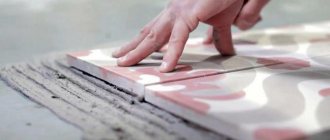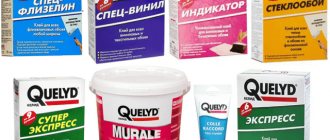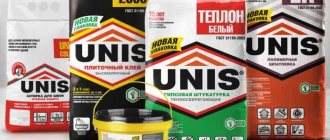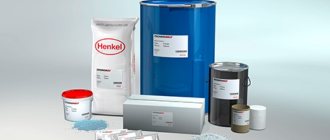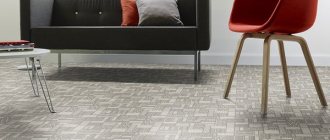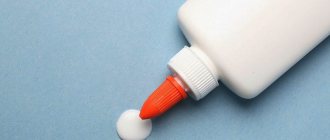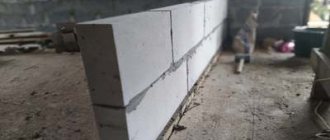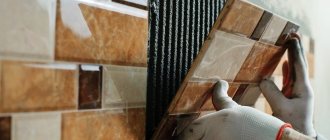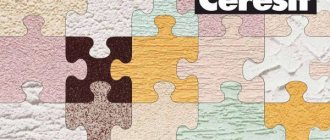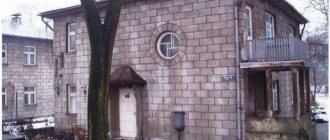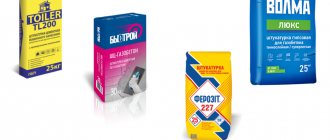Construction from aerated concrete involves laying walls from blocks in compliance with a certain technology. The main task is what to place aerated concrete blocks on?
Let's consider the types of solutions, foam, mixtures and adhesives for laying gas blocks. A comparative analysis of characteristics and properties will allow you to make the right choice. You will find out which glue is better, how much is consumed, when and how to use it, the cost of different manufacturers + tips on preparation and application.
In practice, several types of adhesive mixtures are used for laying aerated concrete. However, there are only two popular options:
What is aerated concrete adhesive?
Such an adhesive composition is a dry construction mixture from which an aqueous solution is made. The proportions of water and mixture are usually indicated by the manufacturer on the packaging. Adhesive for aerated concrete is used as an alternative to conventional cement mortar when carrying out external and internal construction work.
Application area:
- as a putty used when leveling walls;
- when constructing walls from aerated concrete and expanded clay blocks, brick, foam concrete, cinder blocks;
- for laying ceramic tiles.
There are two types of glue that are used in the construction of structures, depending on the season.
Adhesive for aerated concrete can be:
- Gray - considered a winter variety, but, in fact, is universal and suitable for use regardless of the season. The composition includes antifreeze additives, and there are temperature limits for use.
- White - the composition includes Portland cement, which gives the glue a light shade, which is why it got its name. It is considered a summer option and is used in the warm season.
The light color makes it possible to use white glue for aerated concrete blocks indoors and save on finishing materials.
Composition and advantages
The adhesive consists of high quality cement, polymer additives, specially sifted sand and modifiers. Polymer additives improve the thermal conductivity of the mixture and its adhesive properties. Modifiers provide protection against cracking if the ambient temperature rises.
Advantages:
- the possibility of obtaining seams with a thickness of 2-3 mm, which provides a significant reduction in heat loss through the joints and reduces the cost of building construction;
- resistance to low temperatures, with the winter version of the glue you can perform work in the cold season;
- increased moisture resistance;
- no shrinkage during hardening.
It is necessary to store adhesive for aerated concrete blocks only in heated rooms. The solution must also be made in a warm place, the water must be hot (+60˚ C), the finished composition must have a temperature not lower than +10˚ C. In the cold season, the prepared solution must be used up as soon as possible, since after 30 minutes it will lose its qualities.
Selection options
Cellular concrete has special properties that make it impossible to obtain high-quality masonry using conventional cement mortar. This is because the seams will be thick and will cause serious heat loss. Adhesive for aerated concrete blocks in terms of physical properties is very close to the parameters of the building material, therefore it is ideally suited. Ordinary cement mortar does not have such characteristics.
When constructing buildings in the northern regions, it is advisable to use gray glue. Its characteristics do not deteriorate at temperatures from +5˚ C - the composition does not spread and has excellent adhesion. Temperature limits for use are in the range of up to -10˚ C.
Advice! The adhesive composition used during construction in winter must always have a temperature above 0˚ C. This will ensure adhesion and protect against damage during work.
Professionals recommend not to save money when buying aerated concrete adhesive; to choose only brands with an excellent reputation, time-tested, and which consumers speak well of.
Which glue is better can be decided by testing. Buy several different adhesive compositions and try to glue 2 aerated concrete blocks with each of them. After 24 hours, break the connection and carefully examine the joint. The best option is when the block breaks, but the integrity of the seam is preserved, this is the glue that needs to be purchased.
If the connection splits along the seam, the glue is of low quality, do not buy it. In the case where both the gas block and the seam are partially broken, the adhesive mixture is not very good.
Step-by-step instruction
To comply with all masonry rules, follow the instructions:
- Prepare the surface: clean the blocks from dust and dirt.
- Mix the solution to the desired thickness in the required quantity.
- Apply the mixture to the blocks on 2 sides: main and end.
- Place on the masonry and level.
- Excess glue is wiped off with a rag.
For external walls, a joint thickness of no more than 5 mm is used. External walls need to be reinforced to strengthen them, since the building material itself is not strong enough. Internal walls must be connected to load-bearing walls using flexible ties or anchors.
Manufacturers
Professionals recommend several companies that produce glue, which have managed to establish themselves on the positive side in the construction market.
The most popular brands with an excellent reputation:
- "Bonolit" - products appeared on the market relatively recently. The adhesive contains components with modifying and antifreeze properties;
- “Moment” is characterized by high adhesive properties in relation to the building material;
- “Varmit” is a masonry mixture from a Russian manufacturer that contains ash, which increases the strength of the seam, but consumer reviews of the product on forums are not always positive;
- “Volma” - the glue is highly resistant to low temperatures; you can work with it at temperatures down to -15˚ C;
- Kreisel 125 is suitable not only for gas silicate and foam concrete blocks, but also for foam concrete, polystyrene concrete blocks;
- “Creps” is used for masonry inside and outside, at +20˚ C the glue retains its properties for four hours;
- “Real” - the masonry mixture can be worked at temperatures from +5 to +30˚ C, used for external and internal work;
- Ytong - polyurethane adhesive, characterized by increased strength, ability to retain water and excellent adhesive properties, summer and winter varieties are produced, foam glue is produced under this brand;
- AEROC is designed for indoor and outdoor work; white and gray masonry mixtures are available;
- Ceresit CT21 is excellent for external and internal construction work, indoor putty.
Advice! To avoid cold bridges when working with aerated concrete blocks, use fine-grained glue, which ensures uniform masonry.
Proportions for preparing the solution
Features of preparing high-quality glue for blocks:
- You should read the instructions for the product, even if you have previously had experience working with it, because different manufacturers may have different properties and preparation methods.
- For 10 kg of mixture, take about 1.5-2.5 liters of liquid.
- First, water is poured into the container, then the powder is poured. If you do the opposite, lumps will form, and removing them will be problematic.
- For mixing, it is better to use a construction mixer, which is turned on at low speed.
- After obtaining the desired consistency, you need to wait a few minutes and then mix again.
Reference! After preparation, the mixture can be used within 30 minutes, for winter formulations - 2-3 hours. After this time, the properties of the solution begin to deteriorate.
The glue should be mixed in portions, because if it is not used at the specified time, a new solution will have to be prepared, which significantly increases consumption. At any time of the year, it is recommended to maintain the glue temperature at least +10 degrees.
Material consumption is individual for each individual brand. The air temperature during operation also matters. The average consumption is about 15-20 kg per meter. At the same time, some mixtures are used in significantly smaller quantities - up to 2 kg per meter. Consumption will depend not only on the characteristics of the adhesive, but also on the quality of the blocks themselves.
How to put it correctly
The technology according to which aerated concrete blocks are laid on an adhesive mixture is very different from the process of building walls on cement-sand mortar.
Stages:
- Preparation of gas blocks.
- Preparation of the solution.
- Applying adhesive mass to the surface of an aerated concrete block.
- Laying and leveling of aerated concrete blocks.
- Removing excess adhesive mass.
The subtleties of masonry technology are that the block must be clean; applying glue to ice-covered material is strictly prohibited. It is not necessary to additionally moisten the aerated block during the laying process, except for cases when construction is carried out in the heat of summer.
Advice! The proportions for diluting the glue with water and the method of preparing the solution are indicated by the manufacturer on the packaging. Please note that there should not be too much water.
A homogeneous consistency of the adhesive mass can be obtained by stirring it with special attachments that are attached to electric tools (for example, a drill). After the first stirring, let the solution sit for 10-15 minutes. This will ensure complete dissolution of the additives included in the glue. Immediately before use, the glue must be stirred again.
Depending on the brand, the adhesive mass can be used for 2-4 hours. There is no point in diluting the masonry mixture with water that has begun to harden - its beneficial qualities have already been lost.
The glue is applied to the blocks using a notched trowel or a special carriage designed specifically for this type of masonry mixture.
The positive effect of using special tools is to significantly reduce the consumption of adhesive mass, improve adhesion and reduce work time.
How thick the glue layer will be depends on the size of the teeth. To avoid the wall collapsing, the blocks must be placed along a stretched cord. Control of the masonry is carried out using a building level. The blocks are leveled with a rubber hammer, which helps prevent damage to the aerated concrete blocks. Excess glue is cut off after hardening with a trowel.
Masonry mixtures for the first row of aerated concrete blocks
The bottom row of foam concrete should be placed on the CPR. There are two reasons to do this:
- The first row of aerated concrete masonry, according to STO NAAG 3.1-2013, must be protected from capillary moisture. To do this, a waterproofing film should be installed between the surfaces of the foundation and foam concrete.
- In addition, the masonry must be fully supported by the supporting structure to ensure complete load distribution
It is recommended to use adhesives only if the difference in elevation between the highest and lowest points exceeds 5 mm. In practice, such grounds do not occur.
